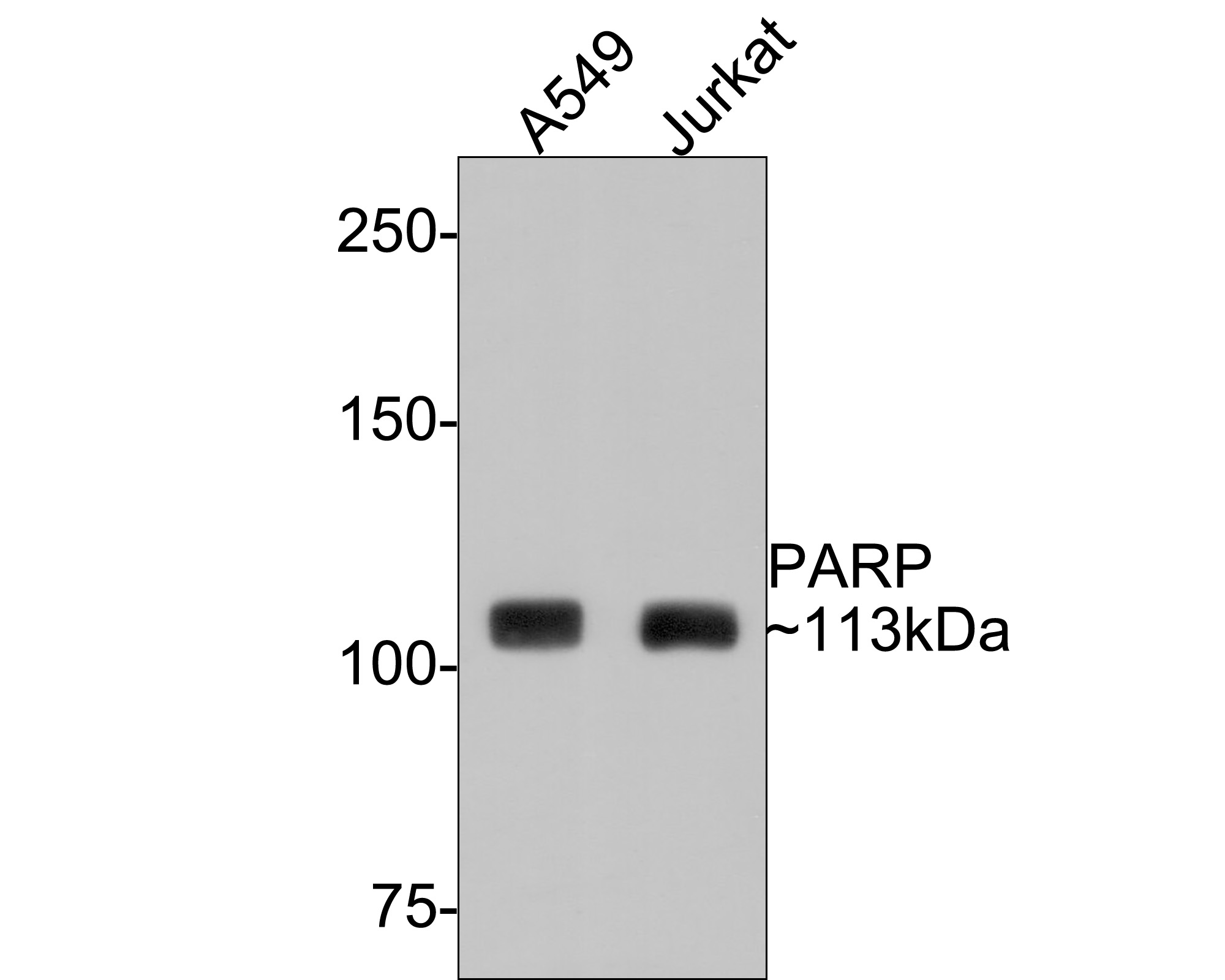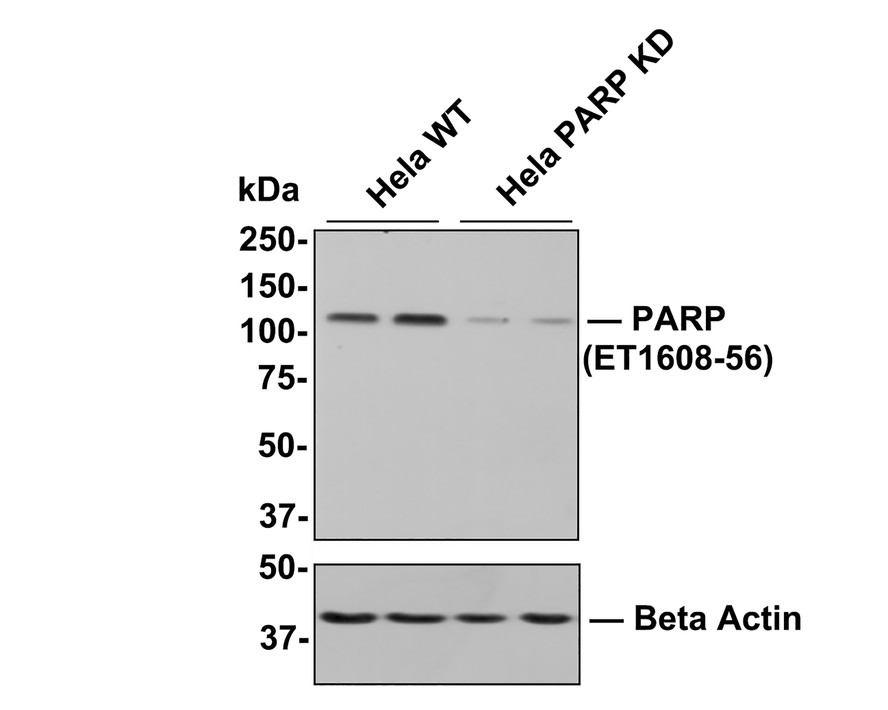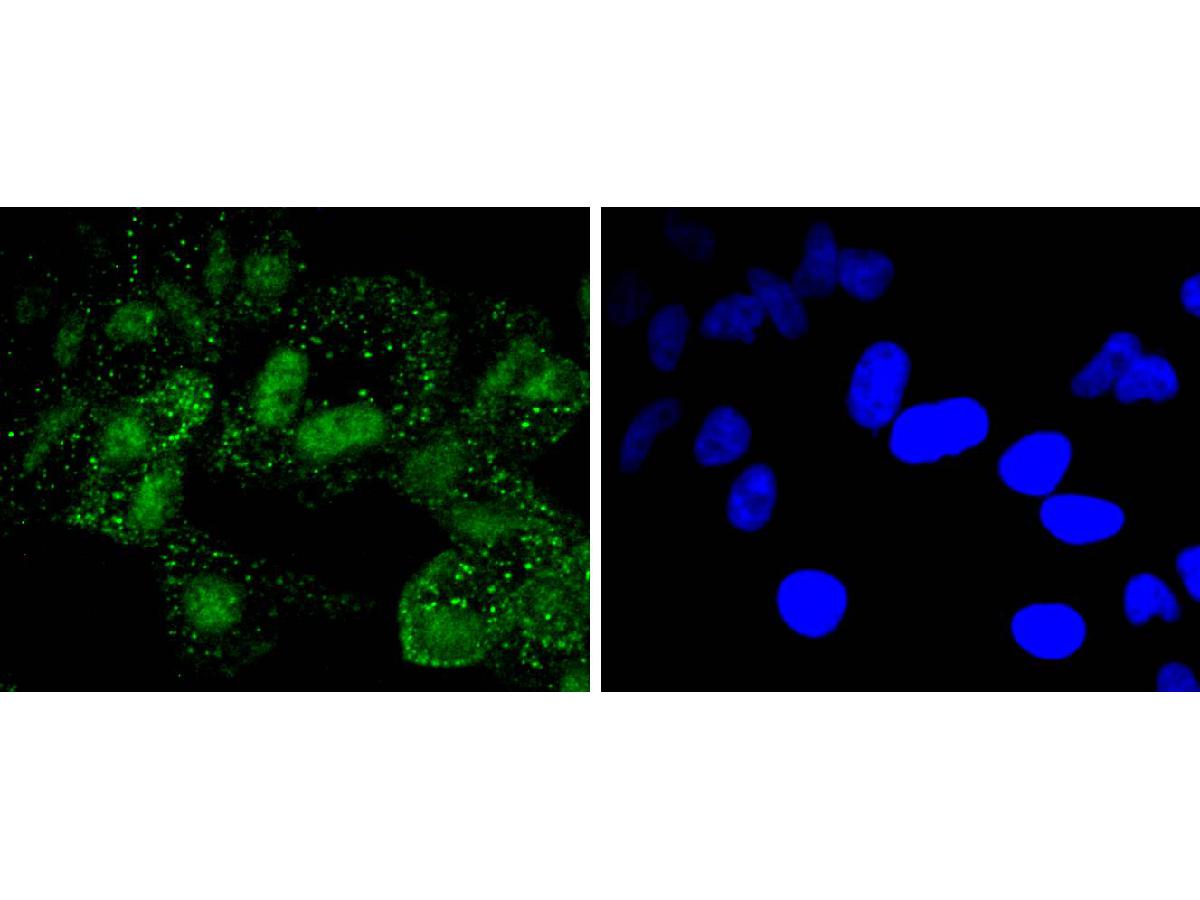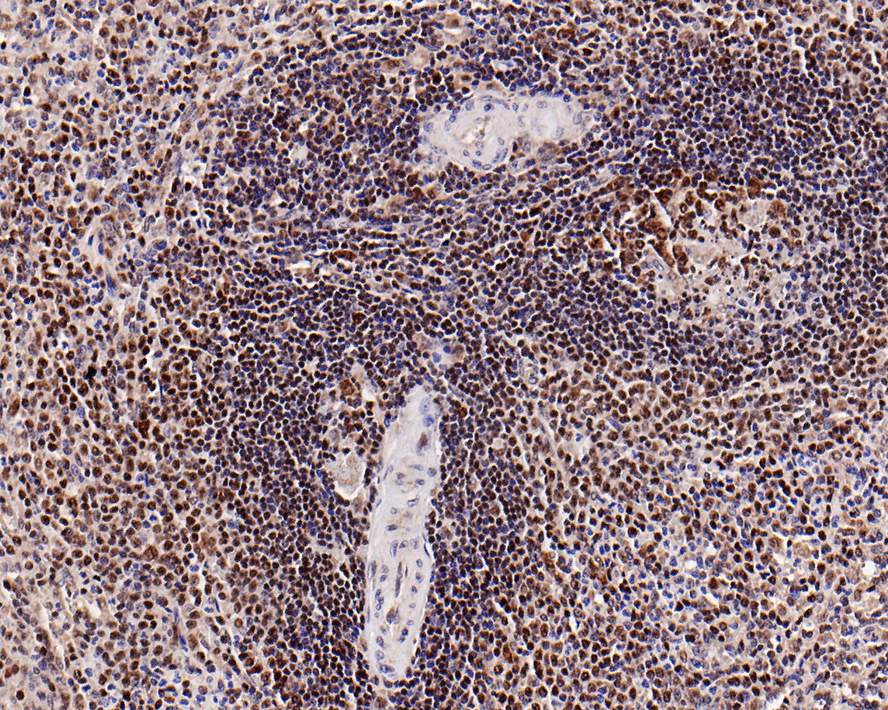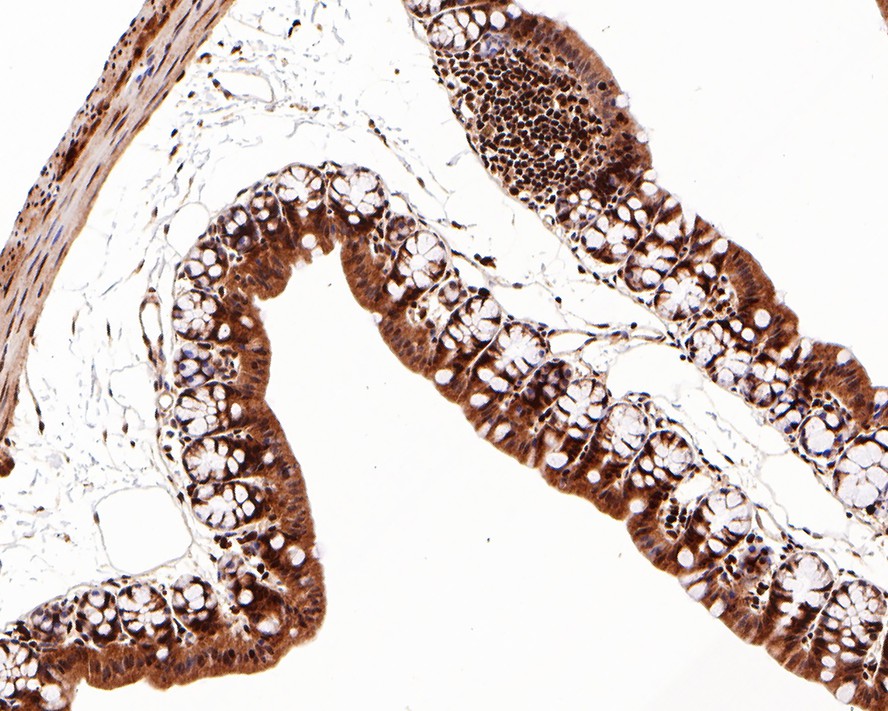- 商城价格 登录后可查看价格
- 货号 ET1608-56
- 品牌 huabio/华安生物 ( 经销商 )
- CAS号
- 规格/包装 50ul
- 单位 支
- 储存条件 -20℃
- 现货状态 一周
-
数量
- +
 成功收藏产品
成功收藏产品 - 立即购买
 热门推荐
热门推荐
-
概述
- 产品描述The main role of PARP (found in the cell nucleus) is to detect and initiate an immediate cellular response to metabolic, chemical, or radiation-induced single-strand DNA breaks (SSB) by signaling the enzymatic machinery involved in the SSB repair. Once PARP detects a SSB, it binds to the DNA, undergoes a structural change, and begins the synthesis of a polymeric adenosine diphosphate ribose (poly (ADP-ribose) or PAR) chain, which acts as a signal for the other DNA-repairing enzymes. Target enzymes include DNA ligase III (LigIII), DNA polymerase beta (polβ), and scaffolding proteins such as X-ray cross-complementing gene 1 (XRCC1). After repairing, the PAR chains are degraded via Poly(ADP-ribose) glycohydrolase (PARG). PARP enzymes are essential in a number of cellular functions, including expression of inflammatory genes: PARP1 is required for the induction of ICAM-1 gene expression by cardiac myocytes and smooth muscle cells, in response to TNF.
- 产品名称Anti-PARP Recombinant Rabbit Monoclonal Antibody [SU03-68]
- 分子量Predicted band size: 113 kDa
- 种属反应性Human,Mouse, Rat
- 验证应用WB,ICC/IF,IHC-P,FC
- 抗体类型重组兔单抗
- 免疫原Synthetic peptide within N-terminal human PARP.
- 偶联Non-conjugated
-
性能
- 形态Liquid
- 浓度1 mg/mL.
- 存放说明Store at +4℃ after thawing. Aliquot store at -20℃ or -80℃. Avoid repeated freeze / thaw cycles.
- 存储缓冲液1*TBS (pH7.4), 0.05% BSA, 40% Glycerol. Preservative: 0.05% Sodium Azide.
- 亚型IgG
- 纯化方式Protein A affinity purified.
- 亚细胞定位Nucleus, nucleolus, chromosome.
-
数据链接SwissProt: P09874 Human
SwissProt: P11103 Mouse
SwissProt: P27008 Rat
-
其它名称
- ADP ribosyltransferase (NAD+; poly (ADP ribose) polymerase) antibody
- ADP ribosyltransferase diphtheria toxin like 1 antibody
- ADP ribosyltransferase NAD(+) antibody
-
应用
WB: 1:1,000
ICC/IF: 1:50-1:200
IHC-P: 1:500
FC: 1:50-1:100
-
Fig1: Western blot analysis of PARP on different lysates with Rabbit anti-PARP antibody (ET1608-56) at 1/500 dilution.
Lane 1: A549 cell lysate
Lane 2: Jurkat cell lysate
Lysates/proteins at 10 µg/Lane.
Predicted band size: 113 kDa
Observed band size: 113 kDa
Exposure time: 1 minute;
6% SDS-PAGE gel.
Proteins were transferred to a PVDF membrane and blocked with 5% NFDM/TBST for 1 hour at room temperature. The primary antibody (ET1608-56) at 1/500 dilution was used in 5% NFDM/TBST at room temperature for 2 hours. Goat Anti-Rabbit IgG - HRP Secondary Antibody (HA1001) at 1:300,000 dilution was used for 1 hour at room temperature.Fig2: All lanes: Western blot analysis of PARP with anti-PARP antibody[SU03-68] (ET1608-56) at 1:500 dilution.
Lane 1/2: Wild-type Hela whole cell lysate (10 µg).
Lane 3/4: PARP knockdown Hela whole cell lysate (10 µg).
ET1608-56 was shown to specifically react with PARP in wild-type Hela cells. Weakened bands were observed when PARP knockdown samples were tested. Wild-type and PARP knockdown samples were subjected to SDS-PAGE. Proteins were transferred to a PVDF membrane and blocked with 5% NFDM in TBST for 1 hour at room temperature. The primary antibody (ET1608-56, 1/500) was used in 5% BSA at room temperature for 2 hours. Goat Anti-Rabbit IgG-HRP Secondary Antibody (HA1001) at 1:200,000 dilution was used for 1 hour at room temperature.Fig3: ICC staining of PARP in Hela cells (green). Formalin fixed cells were permeabilized with 0.1% Triton X-100 in TBS for 10 minutes at room temperature and blocked with 1% Blocker BSA for 15 minutes at room temperature. Cells were probed with the primary antibody (ET1608-56, 1/50) for 1 hour at room temperature, washed with PBS. Alexa Fluor®488 Goat anti-Rabbit IgG was used as the secondary antibody at 1/1,000 dilution. The nuclear counter stain is DAPI (blue).
Fig4: Immunohistochemical analysis of paraffin-embedded human spleen tissue with Rabbit anti-PARP antibody (ET1608-56) at 1/500 dilution.
The section was pre-treated using heat mediated antigen retrieval with Tris-EDTA buffer (pH 9.0) for 20 minutes. The tissues were blocked in 1% BSA for 20 minutes at room temperature, washed with ddH2O and PBS, and then probed with the primary antibody (ET1608-56) at 1/500 dilution for 1 hour at room temperature. The detection was performed using an HRP conjugated compact polymer system. DAB was used as the chromogen. Tissues were counterstained with hematoxylin and mounted with DPX.Fig5: Immunohistochemical analysis of paraffin-embedded mouse large intestine tissue with Rabbit anti-PARP antibody (ET1608-56) at 1/500 dilution.
The section was pre-treated using heat mediated antigen retrieval with Tris-EDTA buffer (pH 9.0) for 20 minutes. The tissues were blocked in 1% BSA for 20 minutes at room temperature, washed with ddH2O and PBS, and then probed with the primary antibody (ET1608-56) at 1/500 dilution for 1 hour at room temperature. The detection was performed using an HRP conjugated compact polymer system. DAB was used as the chromogen. Tissues were counterstained with hematoxylin and mounted with DPX.Fig6: Flow cytometric analysis of PARP was done on Hela cells. The cells were fixed, permeabilized and stained with the primary antibody (ET1608-56, 1/50) (red). After incubation of the primary antibody at room temperature for an hour, the cells were stained with a Alexa Fluor 488-conjugated Goat anti-Rabbit IgG Secondary antibody at 1/1000 dilution for 30 minutes.Unlabelled sample was used as a control (cells without incubation with primary antibody; black).
Fig7: Immunohistochemical analysis of paraffin-embedded human breast carcinoma tissue with Rabbit anti-PARP antibody (ET1608-56) at 1/500 dilution.
The section was pre-treated using heat mediated antigen retrieval with Tris-EDTA buffer (pH 9.0) for 20 minutes. The tissues were blocked in 1% BSA for 20 minutes at room temperature, washed with ddH2O and PBS, and then probed with the primary antibody (ET1608-56) at 1/500 dilution for 1 hour at room temperature. The detection was performed using an HRP conjugated compact polymer system. DAB was used as the chromogen. Tissues were counterstained with hematoxylin and mounted with DPX.
-
背景文献
-
1. Cao C et al. The long intergenic noncoding RNA UFC1, a target of MicroRNA 34a, interacts with the mRNA stabilizing protein HuR to increase levels of -catenin in HCC cells. Gastroenterology 148:415-26.e18 (2015).
2. Gao S et al. Ischemia-reperfusion injury of the retina is linked to necroptosis via the ERK1/2-RIP3 pathway. Mol Vis 20:1374-87 (2014).
 会员登录
会员登录.getTime()%>)
 购物车()
购物车()

